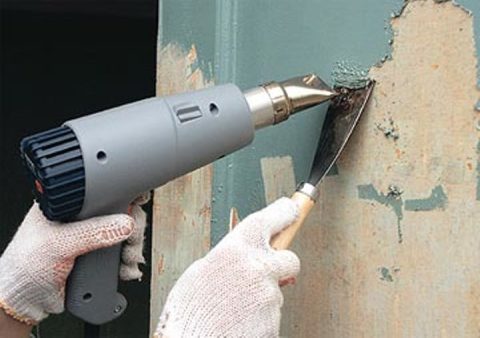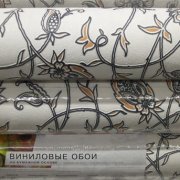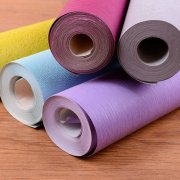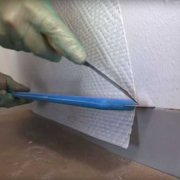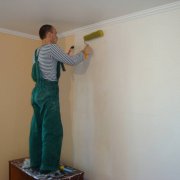Wall repair and wallpaper sticker: do it yourself
Wall repair for wallpaper is almost always done. Sometimes it’s just cosmetic work, but quite often you have to spend a lot of time on it. It all depends on the previous coating and wall material.
Today we will consider how wall repairs are done under the wallpaper sticker in different cases. Also in the video and photo you can find additional materials on this issue.
The content of the article
Wallpapering Rules
In principle, everything can be done qualitatively with your own hands, and then the final price will not be high. Qualitative coverage must be properly prepared base, this is first and foremost.
After all, all efforts to glue will be useless if the wallpaper quickly disappears or just swells. But if you want your repair to last as long as possible, you will have to spend enough time from the very beginning.
It will be wise to listen to the point of view of experienced specialists who advise you to pay attention to the following aspects:
- Firstly, apply the first coat of plaster coat (seeHow to plaster a wall correctly) Standard thickness is from 3 to 9 mm. The degree of density should be similar to sour cream. Thus, all cracks and roughnesses will be filled, which means that there will be no problems with how the plaster will lie in the future.
- Secondly, the coating layer must be up to 6 mm wide. In some cases, it can be expanded.
- Thirdly, then a layer of plaster is applied to smooth and eliminate irregularities. The overlay is applied in a layer thickness of 2 to 4 mm. A thin film forms, which is easily erased later.
- Fourth, ultimately sandpaper is used to level the walls.
Wallpapering Options
Repair and sticker on the wall are interconnected. After all, the previous coating can be quite different and preparation depends on it. Let's look at examples of what is being done and how.
What to do if there are still old wallpapers
Often, each person does not like to mess around with repairs for a long time. And if there are past wallpapers, many people paste new ones onto old ones. This method is extremely erroneous, since the next day it is likely you will have to do the repair again.
So, so that the new wallpaper does not fall off due to the fact that they are glued to the old ones (seeHow to glue wallpaper on wallpaper correctly), they need to be glued to a clean wall. But how to perform this repair procedure without spending too much time and effort? And what is required for this?
So:
- The most important thing is to get all the necessary tools to complete the work efficiently and on time. You will need a spatula, a roller (preferably a spray), water and other additional tools.
- How exactly do you need to pluck the wallpaper? In the area of windows or batteries, you can tear off the wallpaper with your hands, because there they are not so tight to hold, as in other more free places.
- If it is difficult to tear off with your hands, use a spatula. Before that, boil the water, and then spray it on the old wallpaper (if there is no spray, use a roller).
- An excellent effect is vinegar or other detergents added to the water, which contain dissolution elements.
- The fastest and most universal way will be to buy a special tool designed just for removing wallpaper (seeHow to remove wallpaper from the walls correctly and without torment) Of course, this is fast and high quality, but you will not have to pay too.
How to glue wallpaper if the earlier walls were painted
Wallpaper will not hold if glued to a smooth or painted wall. Naturally, if the walls were painted earlier, now they will have to be cleaned of paint anyway (seeHow to remove paint from the walls: the secrets of the masters).
Accordingly, with the implementation of such work a lot of time and effort is spent. Therefore, many lazy and uneducated homeowners decide to take a desperate step. They sand the walls and then apply a primer.
This way is very doubtful and will soon give negative results. For example, wallpaper can fall off in the shortest possible time and at any time. Then how to glue wallpaper on painted walls?
Professionals advise the following:
- Will effectively use a building hair dryer. With it, you heat a specific area of the wall. When the paint softens, it can be removed with a spatula. The method is quite simple, but it can badly affect your health. The bottom line is that heated paint emits bad chemicals from which poisoning occurs.
- You can clean the walls with two devices: a grinder or a grinder with a metal brush. The disadvantage of this method is the large emission of dust. To avoid the detrimental effects, it is important to open the windows and close all the doors. Otherwise, dust will get into undesirable places. It will also be wise to ensure that all slots are also plugged. Then you can start the work itself.
- Complete and quick ink destruction can be achieved using a special wash. Naturally, it is important to observe safety rules before use. Wear rubber gloves, a respirator, and safety glasses during operation. If you do not have this, then it is not recommended to use this method of cleaning walls from paint.
Caution: When the walls are clean of paint, pay attention to possible irregularities. If available, do not start gluing the wallpaper.
If the sinks are not large, then apply a special concrete contact primer. If you want to stick vinyl wallpapers, use glue specially designed for them. You can still sand the walls. However, no method will be as effective as the complete removal of old paint.
How to glue wallpaper after cleaning the walls
When the repair of the walls is completed, the sticker of the wallpaper begins the wallpapering. Now there are a wide variety of types of this material. And for each type, the corresponding steps in sticking.
But there is a feature of the moments that remain the same for all wallpapers. For example, you will need good tools for quality work. Of course, something can be borrowed from a good neighbor, but for better convenience it’s better to have your own.
What exactly do you need tools for wallpapering:
- You can’t start repairs without wallpaper and glue.
- You will always need to remove the old wallpaper, and this can be done with a spatula. The truth before this is to wet the old glue. But if you do not want to suffer for a long time, you can buy a special liquid to quickly eliminate old wallpapers.
- In old houses, the walls are especially uneven, so you have to stock up with putty and plaster.
- After eliminating irregularities, you can adjust the walls more definitively for wallpaper gluing. In this case, you can use sandpaper and primer.
- You may need to unscrew the sockets or skirting boards, and for this you need a screwdriver.
- Not without a clerical knife.
- If you want the wallpaper to be glued strictly vertically, use the level.
- Also, you will need two wide brushes with long hair. The better the brush, the better the adhesive is applied to the wallpaper, and especially at the edges and corners.
- After sticking, it is important to eliminate the irregularities that have arisen.You can get rid of them with an ordinary dry and damp cloth. But in order to remove excess glue, it will be more convenient to use a brush.
- But the most important thing is the stepladder and mood.
If all of the above aspects are observed, you can start working with a calm soul:
- First of all, it will be necessary to prepare the walls. Perhaps they left old wallpaper or painting. Naturally, you get rid of everything unnecessary. In the case of old wallpaper, a liquid specially designed for this is used to quickly remove them.
- If there are financial constraints, you can simply moisten the wallpaper with warm water. Then it comes with a spatula. With it, you clean the wall, and putty all the irregularities and cracks that are discovered. For wallpaper you need a flat and smooth wall, and perhaps for this you need to work somewhere with sandpaper.
- After plastering, do not immediately start work. You should wait a certain time, and then engage in gluing.
- However, immediately rush to glue the wallpaper is not worth it. To save on glue, but not on quality, it is worth priming the surface of the walls. This is mainly necessary so that the walls do not soak up the glue so eagerly. Also, it becomes more possible to adjust wallpaper strips. This means that you can fit the pattern or dock in the right place.
- In the role of material for the primer, wallpaper glue is excellent. Before the primer process itself, you need to make it more liquid. Another big plus of the primer walls is the elimination of fungus and other bacteria.
- You should not waste time in vain, and while the walls absorb the primer material, engage in cutting wallpapers. It is important to inspect all wallpaper rolls to make sure whether there are no differences. Otherwise, glue only part of the wall, and on the other you have to look and buy the same style of wallpaper.
- When the wallpaper is patterned, it is important to note in advance exactly where to make the cut. It is unnecessary to make the wallpaper too close to the end, because a few centimeters of the canvas may be needed.
- Often the wallpaper will need to be shifted. If you want to know the degree of displacement, pay attention to the back of the wallpaper, where there is a corresponding explanation. There you will see a figure that states the degree of displacement. For the convenience of gluing, first place the canvases on the floor, and then alternately start gluing.
Attention: But the main thing is not to confuse the top side with the bottom. When cutting, mark the material.
What glue to use for wallpaper
At first glance, the choice of glue seems ostensibly simple. But do not arbitrarily in this case, because the adhesive has certain parameters.
Attention: You can not choose one glue for all types of wallpaper. It is important to pay attention to the characteristics of the glue, and then make the right and reasonable choice and there is an instruction on the packaging for this.
In general, there are a lot of different adhesives for a variety of wallpapers. For example, for a vinyl canvas, one box of glue is enough, and another type and one will not be enough. And yet, why is the range of adhesive product so great?
- The type of wallpaper is quite diverse, and for each of them there is a certain glue. For example, there are heavy coatings and light ones. For example, paper wallpaper does not require any special substance. Most types of glue are suitable for them. In this case, you do not have to once again overpay funds. Nevertheless, there is a universal type of wallpaper for which universal glue is suitable. And here you want, if you don’t want, you will need to spend money on a suitable option.
- For inexperienced users, there is a very excellent glue with an indicator. What it is? Very often, in their inexperience, you can go too far with glue. For example, in some areas the canvas will be missed, but in another place it’s just a bust. In order to prevent such errors, there is a special glue that, when moistened, acquires a specific color.In this way, applying it, it will be possible to see areas where glue has not yet been applied. It will be especially convenient to lubricate the strip. The indicator will not keep color forever and can dry out in a short time. Therefore, it is important not to hesitate with the process of applying the adhesive.
- There is also a "border" glue that dries very quickly, and it is also very thick. The composition of any glue is in the form of a powder. The adhesive mixture is prepared by dilution with water. But to be more confident, pay attention to the recipe that is placed on the package itself. It is important that lumps do not form in the process, and for this, glue should be slowly poured into the water and constantly stirred. In general, half an hour is enough for sludge.
Basic rules for wallpapering
Perhaps you think that after all the above aspects and nuances, the main work is already behind. But this is not so.
To successfully paste the wallpaper, it is wise to listen to the following tips:
- It’s best to start gluing from the surface of doors or windows. If at first you have the correct vertical reference, then the work itself will go on smoothly;
- Before gluing wallpaper, close windows and doors. The required temperature in the room is not less than 18 degrees, and humidity not more than 70%. Even the humidity level on the walls should not exceed 4 percent. To achieve this result, you can use a primer.
- Sometimes glue will have to be applied only to the wallpaper, sometimes to the wall, and in some cases on both sides. When bubbles appear, you need to take a cloth and smooth everything. Only this must be done carefully so as not to damage the glued canvas. If this does not help and the bubbles still remain, you can take a needle and puncture a place with filled air. After again, smooth with a rag from the center to the edge.
- When applying glue, you do not need to immediately glue the canvas on the wall. You need to wait up to five minutes for the strips of wallpaper to absorb the glue, and then glue the canvas. The main thing is not to linger, so the wallpaper can get wet.
- When pasting an angle, it will be better to use two overlap sheets. For if you stick one, wrinkles may form, or even the canvas will completely disappear.
- If there is an outlet on the canvas, you can cut a circle. But first you can draw a cross. According to this designation, it will be easier to cut a circle, following the cutting in each sector of the cross.
- Time is money. If you need to wallpaper all the rooms, it is better not to pull with this, but to finish each room in a day.
Wall repair and wallpaper sticker are pretty interconnected. These works should be done comprehensively and efficiently. The instruction will not let you miss the details and help you do everything correctly.


